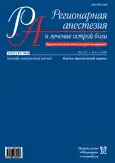Возможность блокады бедренного нерва под уз-контролем с применением электростимулятора периферических нервов малыми дозами ропивакаина
- Авторы: Печерский В.Г.1, Марочков А.В.1
-
Учреждения:
- УЗ «Могилёвская областная больница»
- Выпуск: Том 12, № 4 (2018)
- Страницы: 217-221
- Раздел: Оригинальные статьи
- URL: https://journals.rcsi.science/1993-6508/article/view/61290
- DOI: https://doi.org/10.17816/1993-6508-2018-12-4-217-221
- ID: 61290
Цитировать
Полный текст
Аннотация
Целью исследования является определение возможности использования малых объёмов ропивакаина для блокады бедренного нерва, выполняемой с применением электростимулятора периферических нервов под УЗ-контролем.
Материалы и методы. Выполнено 44 блокады бедренного нерва под УЗ-контролем с применением электростимуляции периферических нервов. В 1-й группе (22 пациента) блокаду бедренного нерва выполняли 10 мл 0,75% ропивакаина; во 2-й группе (22 пациента) применяли 0,75% ропивакаин в объёме 5 мл. Оценка времени развития сенсорного, моторного блоков и длительности анальгезии проводилась с момента начала введения раствора местного анестетика в фасциальный футляр бедренного нерва.
Результаты. Время развития полного сенсорного блока в 1-й и 2-й группах пациентов составило 21 (20; 24) и 30 (24; 35) мин (р<0,05). Время развития полного моторного блока в 1-й группе составило 22 (16; 24), в 2-й группе – 21 (17; 30) мин (р<0,05). Не существовало разницы в продолжительности анальгезии в послеоперационном периоде между группами: 7,75 (7; 8) и 8 (7,5; 8) ч соответственно (р>0,05).
Вывод. Установлено, что для эффективной блокады бедренного нерва достаточно 5 мл 0,75% раствора ропивакаина. При уменьшении эффективного количества и объёма местного анестетика происходит увеличение времени развития полной блокады бедренного нерва без уменьшения периода послеоперационной анальгезии.
Ключевые слова
Полный текст
Открыть статью на сайте журналаОб авторах
Валерий Геннадьевич Печерский
УЗ «Могилёвская областная больница»
Автор, ответственный за переписку.
Email: pechersky.v@yandex.ru
ORCID iD: 0000-0002-6237-8063
врач анестезиолог-реаниматолог
Белоруссия, МогилёвА. В. Марочков
УЗ «Могилёвская областная больница»
Email: pechersky.v@yandex.ru
ORCID iD: 0000-0001-5092-8315
Белоруссия, Могилёв
Список литературы
- Piacherski V. Features and principles the spread of local anesthetic blockade of the sciatic nerve at depends on the amount of anesthetic. Open Journal of Anesthesiology. 2014; 2: 31–5.
- Печерский В.Г. Блокада бедренного нерва малыми дозами местного анестетика. Новости хирургии. 2011; 5: 102–5.
- Piacherski V., Marachkou A. Reducing the Dose of Local Anesthetic Reduces the Duration of Analgesia – Myth or Reality: A Double-Blind Randomized Study. Open Journal of Anesthesiology. 2005; 5: 7–12. doi: 10.4236/ojanes.2015.51002.
- Casati A. Effects of ultrasound guidance on the minimum effective anaesthetic volume required to block the femoral nerve. British Journal of Anaesthesia. 2007; 98 (6): 823–7.
- Taha A.M., Abd-Elmaksoud A.M. Ropivacaine in ultrasound-guided femoral nerve block: what is the minimal effective anaesthetic concentration. Anaesthesia. 2014; 69 (7): 678–82. doi: 10.1111/anae.12607. Epub 2014 May 24.
- Latzke D., Marhofer P., Zeitlinger M., Machata A., Neumann F., Lackner E., Kettner S.C. Minimal local anaesthetic volumes for sciatic nerve blockade: evaluation of ED99 in volunteers. Br. J. Anaesth. 2010; 104: 239-44. doi: 10.1093/bja/aep368.
- Piacherski V., Marachkou A. A Comparison of the Onset Time of Complete Blockade of the Sciatic Nerve in the Application of Ropivacaine and Its Equal Volumes Mixture with Lidocaine: A Double-Blind Randomized Study. Korean Journal of Anesthesiology. 2013; 65: 42–7. http://dx.doi.org/10.4097/kjae.2013.65.1.42
- Gauiter P., Vandepitte C., Ramquet C., DeCoopman M., Xu D., Hadzic, A. The Minimum Effective Anesthetic Volume of 0.75% Ropivacaine in Ultrasound-Guided Interscalene Brachial Plexus Block. Anesthesia & Analgesia. 2011; 113: 951–5.
Дополнительные файлы






